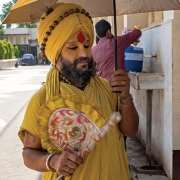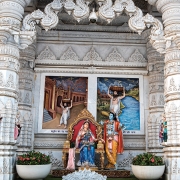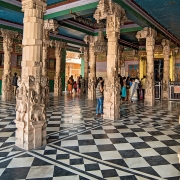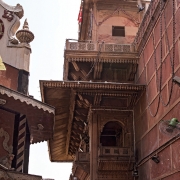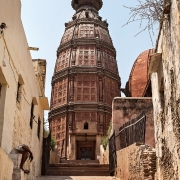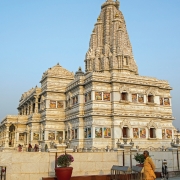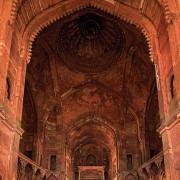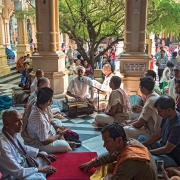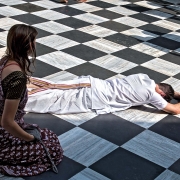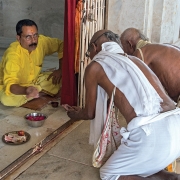
Etcetera
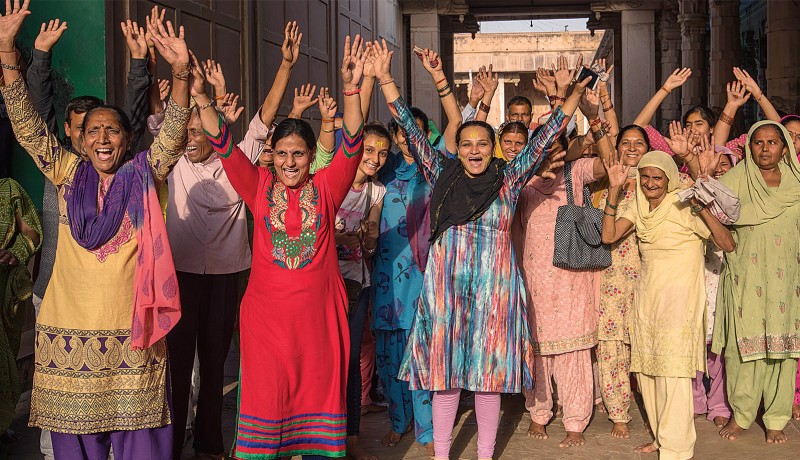
The temple town of Vrindavan pulsates with frenzied devotion
Vrindavan in Uttar Pradesh was a tranquil pastoral village on the banks of the Yamuna when Lord Krishna was growing up. Today, its bucolic origins are scarcely visible amid the chaos of a burgeoning Indian city. The serene notes of Lord Krishna’s flute have been silenced by the cacophony of rickshaws and automobiles that weave through the narrow streets as though on a suicide mission. But the sounds of a city in full throttle have somehow not banished Lord Krishna’s playful spirit in the tranquil temples that dot its streets.
Indeed, Vrindavan revolves largely around Lord Krishna, the impish child who was born in Mathura, 15 km away, and grew up in Vrindavan, endearing himself to everyone with his antics and charm. We weren’t pilgrims in search of Lord Krishna nor had we renounced the world and decided to settle in one of Vrindavan’s ashrams. We were curious but respectful tourists trying to figure out what made Vrindavan tick with such frenzied devotion in its 5,000 temples—old, new and cutting-edge.
And that 24×7 religious high was infectious; we too got swept away by the multitudes as they bowed and prayed in front of garlanded idols even as priests waved flaming diyas and daubed foreheads with vermillion paste. We shed our intellectual curiosity to merge with the tidal waves of collective devotion that roiled through the pilgrim town.
At the curiously named Pagal Baba Temple, a marble 10-storeyed confection, we heard about Leela Nand Thakur, a simple man who kept chanting the Lord’s name. “He was pagal [crazy] about Lord Krishna and would move around with just a red cloth bag,” a temple official informed us. Thakur would dip his hand in the bag, which was somehow always laden with cash, to help the needy. The divine source of his funds could never be explained, but that is how he managed to construct the temple and five ashrams in the country. A priest urged us to go all the way to the top but we were too enervated by the heat. Moreover, we were not powered by the wellsprings of faith that seemed to push others forward, trudging up 10 storeys, treading barefoot on hot stone floors. Instead, we contented ourselves with touring the interior of the temple where puppets and dioramas in glass cases depicted the lives of Krishna and Rama in evocative ways.
During our temple-hopping spree, we discovered that the houses of worship did not conform to one template but an entire spectrum that challenged the imagination. Govind Deo Temple, for instance, turned out to be a grand red sandstone edifice. Once seven-storeyed, it is a three-storey structure in the form of a Greek cross now. Built by Maharaja Man Singh of Amer in 1590, it cost ₹ 10 million. Within, a few tourists gazed at the ceiling which has a beautiful sculptured lotus, said to weigh several tonnes. With its pillars, arches, carved brackets and toran, Govind Deo resembled the palace of a queen rather than a temple.
As we were about to leave the precincts, a young couple from Slovakia asked us for directions and then related their tale of woe—a monkey made off with the woman’s spectacles, a hazard in Vrindavan, where the simian army is prone to not only snatching food from the hands of unwary devotees but spectacles off people’s noses. The cheeky monkey dropped them only when she threw some nuts at him, a trade-off suggested by a helpful local. The more impudent ones rummage in ladies’ handbags—if they are carelessly left open—and make off with mirrors; they groom themselves for hours on end!
Aggressive monkeys aside, navigating the tangle of streets was a challenge as lumbering cows and bullocks often blocked our path. However, we managed to locate the ASI-protected, oldest temple on the block, dating 1580. The red sandstone edifice of Madan Mohan Temple rises on a hillock with its 60 ft-high shikara dominating the skyline. Strong fortified walls encircle it, giving it the air of a fortress. Legend has it that Lord Krishna rested on this hillock after fighting the demon Kaliya who was polluting the waters of the Yamuna.
The mid-19th century Rangji Temple is another gem that explodes with colours. Women from Rajasthan in swirling, red mirror-work ghaghracholi mingled with a handful of Brit tourists in floppy hats, unknowingly presenting us with marvellous photo ops. The temple, built in the Dravidian style with a soaring six storey-high gopuram, has a Rajasthan-style entrance gate and a gold-plated, 54-ft-high pillar. A limpid reservoir and garden add to the temple’s charm. Lord Krishna, an incarnation of Lord Vishnu, enshrined in the main altar of the over 200-pillared complex, is cared for by 108 pundits from the southern reaches of the country.
Monkeys are a serious threat at the 19th century Banke-Bihari Temple too, where we were advised to take off our glasses to avoid an attack. The road leading to the shrine was crowded with devotees, one of whom decided to become our self-appointed guide. “Don’t forget to make a wish, for Lord Banke-Bihari [a manifestation of Lord Krishna] grants whatever you seek,” he said as we pushed through the milling crowds. Nothing had quite prepared us for the swirling ocean of devotion we encountered within. The chanting of prayers and the sudden exuberant invocation of the gods swept like waves over the tightly packed congregation standing shoulder to shoulder. As it seemed almost impossible to get any closer to the central altar, we stood at the door of the rear entrance. Our newfound friend, however, nudged and pushed his way towards the gods and insisted we follow in his wake.
Once close enough to vaguely distinguish the features of the black stone idol smothered in garlands, we stopped and offered a silent prayer. Suddenly, our friend let out a full-throated cry petitioning Banke-Bihari. He waded into the jostling crowd with single-minded determination to grab one of the garlands being tossed around by the pujari. After three close misses, he finally managed to latch onto one that three other hands also claimed as theirs. Yank, tug and he came out with a fistful of flowers of which he gave us a few, saying: “Even with one flower, whatever you wished for will come true.”
On the narrow, stall-lined street outside the temple, we found ourselves blending once more into the rich stew of pedestrian traffic; bewildered kids clinging desperately to their parents, young boys and girls in jeans and T-shirts with caste marks on their foreheads, orange-robed sadhus astride vrooming bikes and a raucous street band.
Religious passion was again at an all-time high at Sheesha Temple, a glass mosaic shrine, and the relatively modern Sri Krishna Balaram ISKCON Temple. The intricately carved marble temple blended spirituality with commerce, with a restaurant-cum-takeaway, a shop selling books on matters spiritual, a guesthouse and a tourist office. Columned passageways, decorated with bright murals portraying episodes from Krishna’s life, formed the backdrop. The singing and chanting were interspersed with the throb of dholak and cymbals. It is said that the tamal tree in the courtyard is the one under which Radha used to wait for Krishna.
Orange-robed, shaven-head devotees prostrated themselves under the sky that arched over the open courtyard; some sat in quiet nooks playing the harmonium and singing bhajans in a self-induced trance. Adjoining the temple is the samadhi of the founder of ISKCON, Swami Prabhupada.
However, the pinnacle of temple architecture in Vrindavan is Prem Mandir which took 11 years to build and threw open its sandalwood doors in 2012. Rising like a gigantic marble wedding cake on a marble platform on lavish 65-acre grounds where musical fountains play at dusk, the temple incorporates 30,000 tonne of Italian marble.
Every inch is intricately carved and outside the sanctum there are flourishes like carved pillars, a gigantic chandelier suspended from a dome that is intricately chiselled to resemble lace, and colourful friezes that portray episodes from Krishna’s life. Marble stairs sweep upwards to the first-floor gallery, which gives an all-encompassing view of the interior. On the walls outside are large-scale murals of Lord Krishna dancing on a snake with seven heads and lifting Govardhan Mountain on a little finger to protect livestock and villagers from the wrath of Indra, the god of thunder.
As dusk fell, the temple was floodlit in different colours—blue, white, pink, purple, green—while the marble platform glowed bone-white. The multitudes, entranced by the sight of a temple that resembled an extra-terrestrial ship that had just soft-landed on earth, heaved a collective sigh of wonder and appreciation.
FACTFILE
GETTING THERE
By air: Though the closest airport is at Agra (62 km), Delhi (170 km) is better connected to the rest of the country.
By rail and road: Mathura, 15 km from Vrindavan, is well-connected by road and rail with the rest of the country.
ACCOMMODATION
There are a number of dharamshalas and private hotels in Vrindavan, although there is no five-star property. There are two UP Tourism properties in Mathura. For more information visit https://uptourism.gov.in/
TIPS
Most temples are open between 6.30 am and 12 noon and then again from 4 pm to sunset. Photography of the sanctum is taboo inside all the ‘living’ temples.
Text & Photos: Gustasp and Jeroo Irani Featured in Harmony — Celebrate Age Magazine August 2017
you may also like to read
-
Cracking the longevity code
Small yet impactful choices can be game-changers, writes Srirekha Pillai At 102, there’s no stopping Chandigarh-based Man Kaur, the world’s….
-
Home, not alone
While a regulatory framework is vital for senior-care facilities, the need of the hour is to develop an ecosystem to….
-
Birthday Girl
Published in a special edition to honour Japanese master storyteller Haruki Murakami’s 70th birthday, Birthday Girl (Penguin; Rs 100; 42….
-
A huge treat for music lovers
Published as the revised and updated second edition, Incomparable Sachin Dev Burman (Blue Pencil; Rs. 599; 470 pages) the authoritative….



